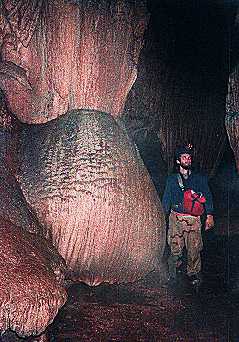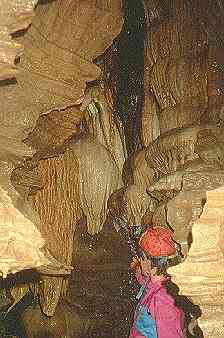Speleothems
 In later stages of cave development, surface water containing dissolved limestone continues to be funneled into the cave system from above. As these waters emerge into the ventilated cave passage, the carbon dioxide is released.
In later stages of cave development, surface water containing dissolved limestone continues to be funneled into the cave system from above. As these waters emerge into the ventilated cave passage, the carbon dioxide is released.  Calcite is preferentially deposited in areas where release of CO2 is facilitated -- creating the stalactites, stalagmites, and other fantastic formations we all enjoy in caves. Scientists call these formations speleothems. The massive deposits shown are found in a Lawrence County cave.
Calcite is preferentially deposited in areas where release of CO2 is facilitated -- creating the stalactites, stalagmites, and other fantastic formations we all enjoy in caves. Scientists call these formations speleothems. The massive deposits shown are found in a Lawrence County cave.
Once removed from the cave environment, speleothems lose their luster and much of their appeal. Cave vandals, in hopes of taking home a souvenir of their stay in a cave, may destroy in a moment what took thousands of years to create. Even the natural skin oils from cavers' hands inhibits futher deposition of limestone. The best way to enjoy speleothems is to "look -- but don't touch."

